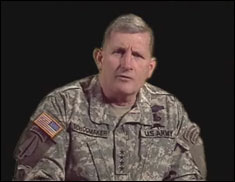Loose blogs may blow up BCTs
By Gary Sheftick
WASHINGTON (Army News Service, Nov. 10, 2005) – This is not your father’s war, Army Chief of Staff Gen. Peter J. Schoomaker tells troops in a videotaped message emphasizing proper Operations Security procedures and responsible use of the Internet.

The video is part of the Army’s comprehensive OPSEC Action Plan that has Mobile Training Teams visiting deploying units to teach how improper information and photographs posted on the Worldwide Web could endanger lives.
For instance, photos of combat operations and destroyed military equipment could provide the enemy with clues about U.S. vulnerabilities, said Maj. Michael Pate, the Army’s OPSEC officer at the Pentagon.
`OPSEC is not censorship’
“This isn’t censorship,” Pate said about the OPSEC plan he had a key role in devising. “It’s about striking a balance between freedom of expression and protecting sensitive military information.”
In World War II and Korea, it took a long time for information to move from the battlefield to the public, Schoomaker says at the beginning of his video. Today with the Worldwide Web, it’s immediate with the push of a button.
CSA: Info-tech explosion global
“We have an information-technology explosion that is global,” Schoomaker said. “Our adversaries have the ability to take our utterances, our writings and our pictures and do all kinds of things to harm us.”
Web logs, or blogs, are a venue where instances of unauthorized photos and some sensitive information have been inadvertently disseminated, Pate said.
MNC-I first with blog policy
So the Multi-National Corps-Iraq headquarters came up with a policy for the increasing number of Soldiers posting blogs in theater. Some of the Soldiers found that posting a periodic blog to the Web was easier than sending multiple e-mails to friends and family. Others have found a modicum of fame for their descriptive coverage of life in the combat zone.
The MNC-I policy requires Soldiers to register their blogs through their unit chain of command. A list of blogs is maintained at the division level, complete with Web addresses and points of contact.
The policy also identifies established elements such as Army Web Risk Assessment Cells and Information-Assurance teams that assess Web sites and monitor information for compliance with Army policy. Such information includes classified info, casualty information before next-of-kin notification, info prohibited by the Privacy Act and details of incidents under investigation.
Commanders are able to develop their own OPSEC policy addressing blogs, Pate said, under the umbrella of Army policy and guidance.
OPSEC plan comprehensive
The Army’s new OPSEC initiatives are comprehensive and range from individual to institutional training, Pate said.
The Mobile Training Teams provide unit-level training, Pate said, to priority-one units scheduled to deploy. The MTTs come from the Army OPSEC Support Element established earlier this year out of the 1st Information Operations Command (Land). located at Fort Belvoir, Va.
MTTs recently visited the 101st Airborne Division (Air Assault) to provide OPSEC instruction to one of its brigade combat teams at Fort Campbell, Ky.
Smaller units can access OPSEC training modules through Army Knowledge Online, Pate said. He said users can click on center right of the AKO front page on “Army OPSEC News,” sign in again using their AKO password and enter the OPSEC Portal.
The OPSEC Portal includes a number of Power-Point briefings that Pate said assist in satisfying OPSEC training requirements.
(Editor’s note: You can access the OPSEC website here. You will be prompted to provide your AKO ID and password.)